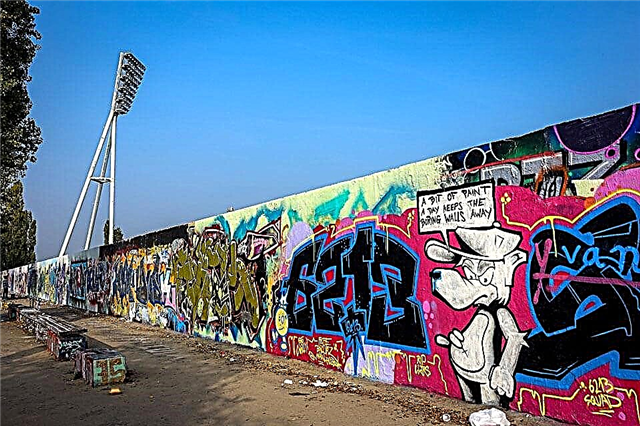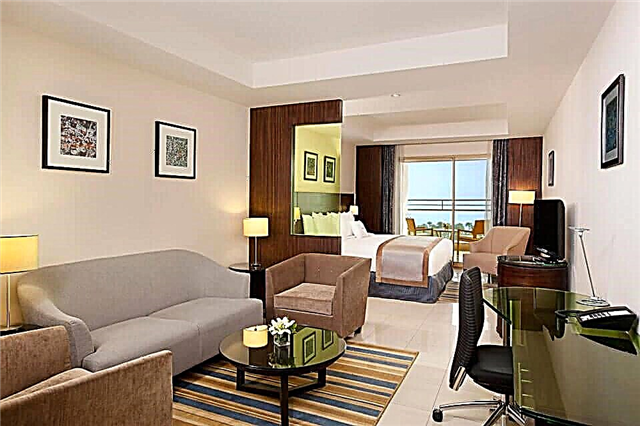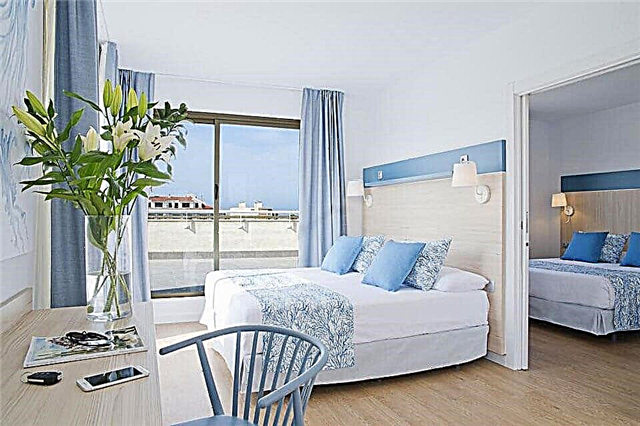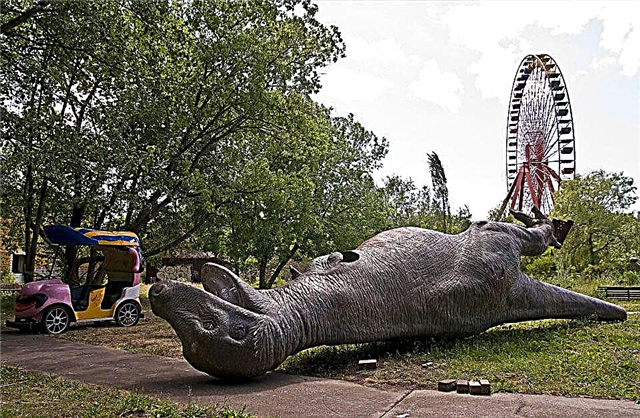Berlin is deservedly called one of the greenest European capitals. The metropolis is famous for its numerous well-groomed squares and gardens where you can spend your time pleasantly and calmly. The total area of all plantations exceeds 5,000 hectares. Each area of the city has its own picturesque oases. Berlin's parks are of historical, aesthetic and ecological value. Garden complexes are examples of landscape art.
Tiergarten

The largest green oasis in the German capital is the Tiergarten park area. It is a favorite vacation spot for residents and visitors of Berlin. Here you can get away from the hustle and bustle of the big city. The picturesque corner occupies a vast territory of more than 200 hectares. Neatly trimmed lawns, hedges and water bodies coexist with natural woodlands, spacious meadows and steep ravines. The park is covered with a network of well-groomed paths, the total length of which is about 30 kilometers.

The Tiergarten is one of the oldest parks in Europe. Its history dates back to the 16th century. The magnificent place served as the hunting ground of the German kings. Wild animals were launched into the fenced area of the forest to provide trophies for the successful hunt of senior government officials. At the end of the 18th century, the privileged area became a public park. While walking leisurely through the beautiful natural landscape, tourists can see many attractions.
These are monuments, memorial complexes, tea houses and old buildings. Of interest is the alley of sculptures of famous personalities of Germany and the memorial to the fallen Soviet soldiers during the Patriotic War. In the center of the park, the Victory Column rises upward, erected in honor of the triumphant military campaigns of Prussia against France, Austria and Denmark in the 19th century. Its height reaches 67 meters. At the top of the monument is a gilded statue of the goddess Victoria, who holds a laurel wreath and a wand in her hands.
Lustgarten

Not far from the Berlin Cathedral there is a wonderful cozy Lustgarten square. At various times, military parades and massive political demonstrations were held here. Military cataclysms of the 19th-20th centuries have distorted the park zone more than once. Having survived periods of desolation, oblivion and devastation, this current magnificent equipped corner pleases the eye with the beauty of landscape design.
Neat lawns with green grass are divided by straight paths into several sectors. Ornamental trees and shrubs have been planted along the perimeter of the park. Benches, animal figures and a fountain are conducive to a leisurely stroll. The Lustgarten is home to the Museum of Ancient Art. A majestic granite bowl with a diameter of seven meters is installed in front of the building.
Treptower Park

Among the green corners of Berlin, Treptower Park, which stretches in the southeastern part of the city, stands out. The vast well-groomed territory, the area of which is 90 hectares, is famous not only for its size and plantings. It is here that a memorial complex was erected dedicated to the victorious Soviet soldiers who liberated the world from fascism. Treptow Park combines features of river, forest and meadow landscape. All this is conducive to a pleasant walk.
The entrance to the park area is a triumphal arch. It depicts the eternal words to the fallen heroes. Further, visitors are greeted by a small monument "Grieving Motherland". The alley of weeping birches, embodying the Russian nature, leads to the symmetrical huge pedestals of a red hue. This is a kind of gate, symbolizing the bowed banners. On both sides of the granite structure stand, kneeling and bowing their heads, sculptures of two soldiers. The perfect detailing of the images is striking.

Alleys with snow-white sarcophagi appear before visitors to the park. Each of them is covered with carved bas-reliefs depicting various episodes of the battles of the valiant heroes of the defenders of humanity from the fascist regime. About seven thousand Soviet soldiers who died during the liberation of the city are buried here.
The central object of the complex is a bronze monument to the Soldier-Liberator, erected on the mound. The height of the sculpture together with the pedestal is 12 meters. The figure of a Red Army soldier on one hand holds a rescued German girl, with the other hand he cuts a fascist swastika with a sword. The monument can be approached by going up the stairs. Sergeant Nikolai Maslov serves as the prototype of the monument. Most Berliners who are interested in military history know about his feat.
Berlin Botanical Garden

The Berlin Botanical Garden invites its guests to get acquainted with a very impressive collection of flora. A visit to the garden will decorate any tourist program of the guests of the capital of Germany. The territory is divided into thematic zones, which are dominated by their own colorful atmosphere of fragrant aromas. Founded in the 19th century, the park was originally a recreation area with green lawns, flower beds, and artificial lakes. Over time, a cozy corner has turned into a research center, which has grown about 22 thousand species of plants.
There are several greenhouses on the territory of the garden, where various exotic flowers are grown. Visitors to the park can see blooming orchids, cacti, banana bushes, coffee trees, camellias, ferns, baobabs, rhododendrons, bamboo and many other tropical flora exhibits. Insectivorous flowers deserve special attention. Tourists will be shown the process of eating insects by predatory plants.
It will be a great pleasure to walk along palm alleys, conifers, alpine meadows, neatly trimmed shrubs and marshes with heather thickets. The unique landscape of the garden is decorated with natural compositions from around the world.
Reichstag

The main architectural landmark of Berlin is the Reichstag building. This is one of the most famous parliament buildings in the world. In 1945, the majestic building became the main target of the Red Army. It was stormed by Soviet troops, and by hoisting the banner of victory on the dome, an end was put in the Great Patriotic War.
In front of the Reichstag building, there is an impressive green lawn where you can lie down or sit on a perfectly trimmed lawn. Here tourists take beautiful photographs against the backdrop of the famous building. Benches are installed only along the road. In the neighboring park, townspeople and guests continue their walk. Street performers and entertainers regularly stage various performances for them.
Berlin WelcomeCard: travel, discounts and guide - € 19.90
Hop-on hop-off bus tour for 24 or 48 hours - from 22 €
Ticket for a quick visit to the TV tower - 21.50 €
Priority entrance: Berlin TV Tower with window seat - 23.50 €
Coffee at the Käfer restaurant on the roof of the Reichstag - € 19.90
Panoramapunkt ticket - 7.50 €
Berlin museums admission: 3-day pass to 30+ museums - 29 €
Peace Gardens in Marzahn

In the east of the capital of Germany, in the Marzahn area, there is a picturesque and cozy corner filled with an atmosphere of peace, silence and tranquility. These are amazingly beautiful gardens, where cultural traditions and stylistic features of landscape art of different peoples - Japanese, Chinese, Koreans, British, Balinese, Moroccans, Italians and many other nationalities - have been recreated.
Aesthetic pleasure is given by admiring the numerous exotic tropical and oriental plants. Here you can see the blooming of sakura, lavender, rose, lilac, jasmine, chrysanthemum and azalea. Pine, bamboo, oak and maple alleys are filled with beautiful sculptures and mysterious totems that, according to legend, protect the area from evil spirits.
Garden pavilions, classic ponds with bridges thrown over them, waterfalls, fountains and stone compositions form amazing landscapes. Intricate buildings arouse genuine curiosity, including teahouses, greenhouses, graceful gazebos and pagodas. The eastern garden, surrounded by a four-meter wall, deserves attention. It is decorated with artsy buildings with mosaic panels, rounded vaults, colorful ornaments, tiles, arches and columns. The varied color of the plants saturates the garden with pink and purple colors.
Friedrichshain People's Park

The oldest place for recreation and entertainment for Berliners is the Friedrichshain People's Municipal Park. Its opening took place in 1848 at the initiative of King Frederick II of Prussia. In this landscaped corner, you can leisurely stroll along well-groomed paths, lie on a green lawn under the lush crowns of trees. Theatrical performances and open-air film screenings are regularly held here. There are picnic areas.
The territory of Friedrichshain is replete with walking paths, playgrounds and sports grounds, gazebos and restaurants. The main attraction of the park is a four-stage fairytale fountain complex with an arched gallery. The pool is decorated with sculptural compositions in the form of characters from the fairy tales of the Brothers Grimm, known from childhood to every German. Nearby, on the banks of a large pond, there is a Japanese garden with a pavilion, where a bell is installed, symbolizing the struggle of civilized mankind against the atomic threat.
Mauerpark

True collectors, lovers of antiques and hunters for "treasures" of bygone eras should go to Mauerpark. This is an impressive flea market, where every Sunday there is a special unique atmosphere of searching for rarities. Here you can find unique tableware, paintings, vinyl records, stamps, rare jewelry, books, clothes, furniture and many other rarities. Mauerpark is located where part of the infamous Berlin Wall ran until the late 1980s.

After its demolition, a vacant lot appeared, which was chosen by local residents, bravely fighting to preserve the space from mass development. A truly festival mood is created by street musicians and artists of different genres, who show their art next to the market, delighting everyone around with their talented abilities. A piece of the Berlin Wall, stretching for 800 meters, has been preserved in the park. Left as a monument, the wall is decorated with colorful drawings, graffiti and inscriptions.
Humboldhain

On the northern outskirts of Berlin, next to the train station, is the Humboldhain People's Park. Since 1869, this cozy corner has been a resting place for the workers of nearby factories. Inhabitants of the surrounding area appreciate Humboldhain for avenues of fragrant roses, a dense grove of tall, spreading deciduous trees, a garden with trimmed shrubs and picnic lawns. Numerous shops are literally buried in the green of the hedge.

Picturesque plantings contrast with the preserved anti-aircraft tower from the times of the Third Reich. A grandiose fortification concrete structure rises on a hill, where a staircase and a neatly paved serpentine path lead. The top of the battery is used as an observation deck.
Britzer Park

The landscape gardening complex Britzer is a classic example of a picturesque park in Berlin, where you can relax away from the bustle of the city. It is forbidden to walk dogs and ride a bike here. The place is designed for quiet outdoor activities, picnics, sports and reading books. The territory of over 90 hectares attracts visitors with its natural surroundings, interesting structures and sculptures. Tourists are expected by neatly trimmed lawns, a variety of trees with lush crowns, lawns with roses, rhododendron groves and numerous flower beds.

The garden is especially popular in May, when the blooming sakura fills the color of the park area with pink colors. The central part of Britzer is occupied by an artificial lake with bays and islets. There are many bridges across the pond. The banks are bordered by stone embankments. One of the spacious lawns has a sundial showing the time, day and month. A path with triangular arches entwined with lianas is laid through the garden complex.
Victoria Park

The park complex "Victoria" is laid out on the slopes of a natural hill in the Berlin district of Kreuzberg. A large number of people of different ages gather in a cozy picturesque place every day. Amazing landscapes favor a leisurely stroll among elms, oaks and ash trees. An expressive attraction of the park is the national monument, erected in honor of the end of the liberation war against Napoleon in 1813-1815. The monumental composition is a twenty-meter high tower made in the Gothic style.
It is decorated with cast-iron ornamental elements, sculptures and numerous pinnacles, directed upward. At the foot of the monument, an artificial cascading waterfall gushes and gracefully flows down the slope, which gives the place a special charm. In the immediate vicinity of the brook there is a beer garden, where visitors can enjoy fresh German draft beer. Tables with comfortable chairs are set out on the terrace surrounded by woodland.
Abandoned amusement park Spreepark

Spreepark is one of the most mysterious and mystical corners of the capital of Germany, which is an abandoned amusement park from the times of the GDR. Once a favorite vacation spot for adults and children, it now attracts only lovers of dark sensations and curious tourists. Only desolate entertainment pavilions and rusty carousels overgrown with bushes and grass remind of the former festive atmosphere that prevailed in the Spreepark from 1969 to 1989.

Destroyed roller coasters, the remains of elements of the structures of attractions, an abandoned children's railway and frayed sculptures that recently hospitably welcomed visitors are catching up with melancholy. A huge Ferris wheel rises above a pond covered with mud. With gusts of wind, the huge structure begins to spin, emitting a chilling grinding of iron.
Zoo

Enthusiastic impressions will remain in the memory of tourists for many years from visiting the Berlin Zoo, one of the main attractions of the German capital. More than 15 thousand species of animals live and live on the beautifully manicured territory, immersed in vegetation. The menagerie was founded in 1884. It hosts about 2.5 million people annually. The 35-hectare zoo is divided into themed sections - aviaries, an aquarium and a terrarium.
For numerous representatives of the fauna, favorable conditions of existence have been created, as close as possible to their natural habitat. Spacious open enclosures are equipped with everything necessary for a comfortable and free living of animals. This is facilitated by natural reliefs: green lawns, shady alleys of tall lush trees, sandy glades, ponds with rocky shores, stone boulders.Tourists will admire elephants, giraffes, bears, rhinos, tigers, monkeys, deer, hippos, lions and many other animals.

Pandas, gorillas and kiwi birds can be seen in exotic pavilions. Penguins and fur seals frolic in the pool to the joyful exclamations of the spectators. Some heat-loving animals are kept in closed enclosures behind glass. The pride of the Berlin Zoo is the Oceanarium, which occupies three floors of the building. The unique underwater world is widely represented here. Flocks of colorful fish, jellyfish, seahorses, sharks, rays and other representatives of the underwater kingdom swim in 250 aquariums.
Peacock island

In the vicinity of Berlin, on the Havel River, there is a unique park complex - Peacock Island. This place is declared a nature conservation monument of the world heritage by UNESCO. The area of the island is over 60 hectares. King of Prussia Friedrich Wilhelm II was still engaged in its arrangement. At the end of the 18th century, the monarch ordered to arrange a picturesque landscape garden on the island, create a nursery for peacocks and build a small snow-white Gothic castle, which has survived to this day in its original form.

Glades, pastures, spacious meadows and wide avenues of oak trees served as a secluded place for the royal family and a refuge for various animals. In addition to the castle with two symmetrical towers, several buildings were built here at different times: a cavalry house, a dairy farm and utility warehouses. An antique portico lurks among the dense deciduous thickets.
The current territory of the park complex is open to everyone. Here tourists can enjoy the natural scenery, have a picnic and admire the architectural sights. The real owners of the island are still peacocks, proudly, freely and imposingly walking along the paths. They are not at all afraid of guests and gladly accept delicacies.
Körnerpark

In a typical residential area of the German capital, there is one of the most picturesque and romantic corners of the city - the Körnerpark park recreation area. It was founded at the beginning of the 20th century on the site of a gravel pit. The ennobled area is surrounded by a retaining wall, since the park is divided seven meters below street level. Manicured lawns, large trees, hedges, rhododendron alleys, plant pots and flower beds create a pleasant atmosphere for relaxation.

In the western part of the Körnerpark there is an old building - a greenhouse with a terrace, a cafeteria and an art gallery. Stairs, balusters, balustrades and sculptures captivate with their sophistication. A cascading fountain is installed on the eastern side of the park. Walking is prohibited on the central green lawn, framed by a water channel. This is indicated by an information plate.











